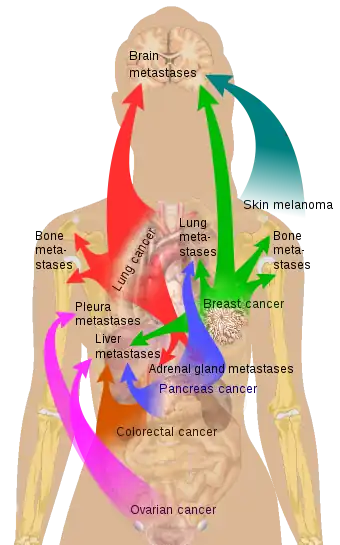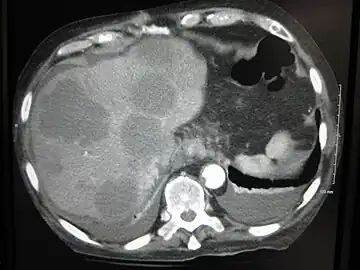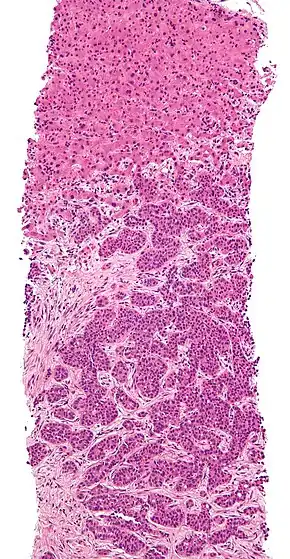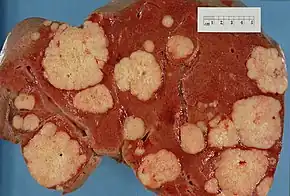Metastatic liver disease
| Metastatic liver disease | |
|---|---|
 | |
| Specialty | Oncology |
| Symptoms | Weight loss, tiredness, epigastric pain, jaundice, hepatomegaly,[1] ascites, confusion[2] |
| Risk factors | Bowel cancer, breast cancer, lung cancer, pancreatic cancer, melanoma, stomach cancer, kidney cancer[3] |
| Diagnostic method |
|
| Frequency | Most common type of liver cancer[3] |
Metastatic liver disease is the spread of cancer to the liver from another organ affected by cancer.[1] These include most frequently bowel cancer, but also cancer of the breast, stomach, lung, pancreas, kidney and skin.[3][4] Symptoms are typically vague and include weight loss, tiredness and upper stomach ache.[2] There may be yellowish eyes and the liver may be large and easy to feel.[1] A large abdomen and confusion often occur in the later stages of the disease.[2]
The liver is a common site for metastatic disease because of its rich, dual blood supply (the liver receives blood via the hepatic artery and portal vein). Tumor emboli entering the sinusoids through the liver blood supply appear to be physically obstructed by the Kupffer cells, but if tumor emboli are larger, they tend to become lodged in the portal venous branches.
Tests include a blood test to look for raise liver enzymes.[1] Ultrasound, CT scan, MRI scan and PET scan are used to investigate the origin of the cancer and to define the extent of disease.[1][4] Taking a sample of liver tissue, guided by medical imaging, may confirm the diagnosis.[2] Treatment generally involves treating the original cancer and cutting out parts of affected liver.[1][4] Other therapies include chemotherapy, radiofrequency ablation, thermal therapy and cryotherapy.[1] Medicines such as bevacizumab and cetuximab and immunotherapeutic agents, may be other options.[4] The choice of treatment and the outcome may be guided by genetic tests.[4]
It is the most common type of liver cancer.[3] Metastatic tumors in the liver are 20 times more common than primary tumors. In 50% of all cases the primary tumor is of the gastrointestinal tract.
Signs and symptoms
Symptoms are typically vague and include weight loss, tiredness and upper stomach ache.[2] There may be yellowish eyes and the liver may be large and easy to feel.[1] A large abdomen and confusion often occur in the later stages of the disease.[2] Other symptoms may include fever.
Diagnosis
Tests include a blood test to look for raise liver enzymes.[1] Ultrasound, CT scan, MRI scan and PET scan are used to investigate the origin of the cancer and to define the extent of disease.[1][4] Taking a sample of liver tissue, guided by medical imaging, may confirm the diagnosis.[2]
- Hemoglobin decrease
- Liver function test: ALP elevated, bilirubin elevated, albumin decrease, gamma glutamyl transpeptidase (GGT) elevated
- Carcinoembryonic antigen for colorectal secondaries
- Ultrasound scan and CT scan - multiple filling defects.
 Axial CT of the abdomen showing multiple liver metastases
Axial CT of the abdomen showing multiple liver metastases
 Cross section of a human liver, taken at autopsy examination, showing multiple large pale tumor deposits. The tumor is an adenocarcinoma derived from a primary lesion in the body of the pancreas.
Cross section of a human liver, taken at autopsy examination, showing multiple large pale tumor deposits. The tumor is an adenocarcinoma derived from a primary lesion in the body of the pancreas. Metastatic disease to the liver
Metastatic disease to the liver
Treatment
Treatment can consist of surgery (hepatectomy), chemotherapy and/or therapies specifically aimed at the liver like radiofrequency ablation, transcatheter arterial chemoembolization, selective internal radiation therapy and irreversible electroporation. For most patients no effective treatment exists because both lobes are usually involved, making surgical resection impossible. Younger patients with metastases from colorectal cancer confined to one lobe of the liver and up to 4 in number may be treated by partial hepatectomy. In selected cases, chemotherapy may be given systemically or via hepatic artery.
In some tumors, notably those arising from the colon and rectum, apparently solitary metastases or metastases to one or other lobes may be resected. A careful search for other metastases is required, including local recurrence of the original primary tumor (e.g., via colonoscopy) and dissemination elsewhere (e.g., via CT of the thorax). 5-year survival rates of 30-40% have been reported following resection.
When resection for cure is not possible (R0 resection), percutaneous ethanol injection has been suggested to dehydrate and kill the tumour cells, however there is not enough evidence to determine the effectiveness and safety of this approach.[5]
References
- 1 2 3 4 5 6 7 8 9 10 11 Foster, Graham; O'Brien, Alastair (2020). "34. Liver disease". In Feather, Adam; Randall, David; Waterhouse, Mona (eds.). Kumar and Clark's Clinical Medicine (10th ed.). Elsevier. p. 1308. ISBN 978-0-7020-7870-5. Archived from the original on 2021-12-11. Retrieved 2021-12-10.
- 1 2 3 4 5 6 7 8 "Metastatic Liver Cancer - Liver and Gallbladder Disorders". MSD Manual Consumer Version. Archived from the original on 26 February 2018. Retrieved 10 December 2021.
- 1 2 3 4 Vaickus, Louis J.; Suriwinata, Arief A.; Iwai, Masaki (2019). "18. Metastatic liver tumors". In Hashimoto, Etsuko; Kwo, Paul Y.; Suriawinata, Arief A.; Tsui, Wilson M. S.; Iwai, Masaki (eds.). Diagnosis of Liver Disease (Second ed.). Singapore: Springer. pp. 269–280. ISBN 978-981-13-6805-9. Archived from the original on 2021-12-11. Retrieved 2021-12-10.
- 1 2 3 4 5 6 7 Tsilimigras, Diamantis I.; Brodt, Pnina; Clavien, Pierre-Alain; Muschel, Ruth J.; D’Angelica, Michael I.; Endo, Itaru; Parks, Rowan W.; Doyle, Majella; de Santibañes, Eduardo; Pawlik, Timothy M. (15 April 2021). "Liver metastases". Nature Reviews Disease Primers. 7 (1): 1–23. doi:10.1038/s41572-021-00261-6. ISSN 2056-676X. PMID 33859205. Archived from the original on 14 May 2021. Retrieved 10 December 2021.
- ↑ Swierz, Mateusz J.; Storman, Dawid; Riemsma, Robert P.; Wolff, Robert; Mitus, Jerzy W.; Pedziwiatr, Michal; Kleijnen, Jos; Bala, Malgorzata M. (April 2020). "Percutaneous ethanol injection for liver metastases". The Cochrane Database of Systematic Reviews. 2020 (2): CD008717. doi:10.1002/14651858.CD008717.pub3. ISSN 1469-493X. PMC 7000212. PMID 32017845.
External links
| Classification |
|---|